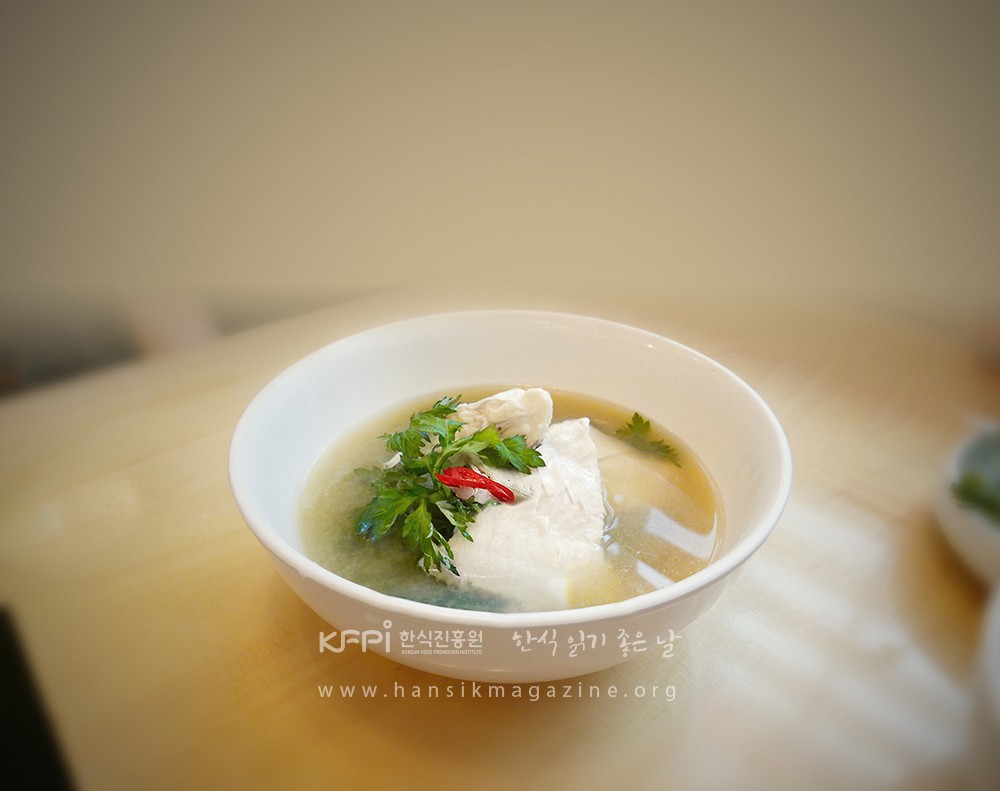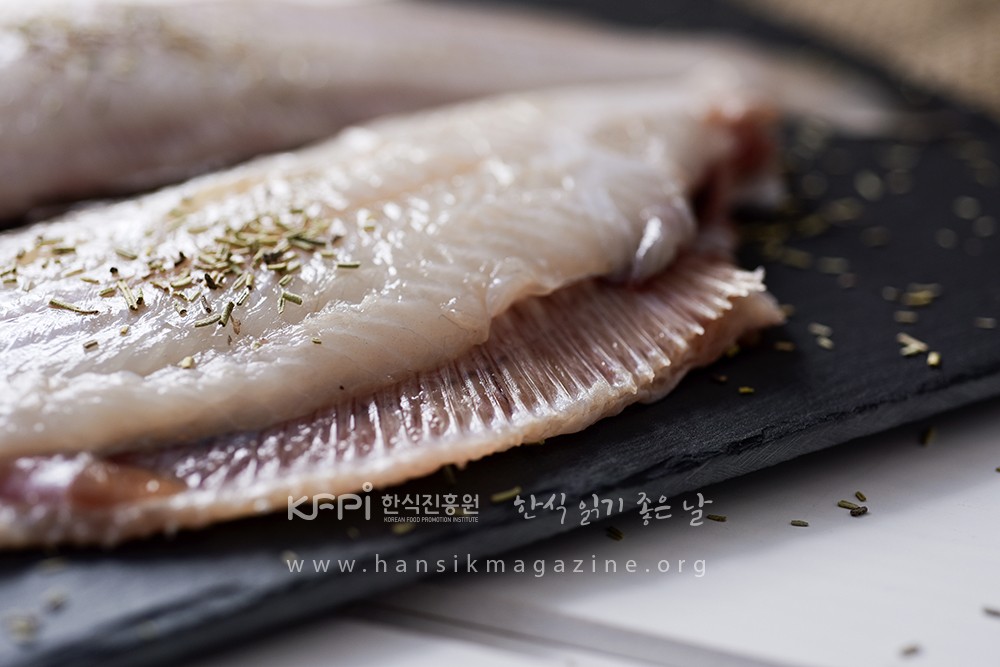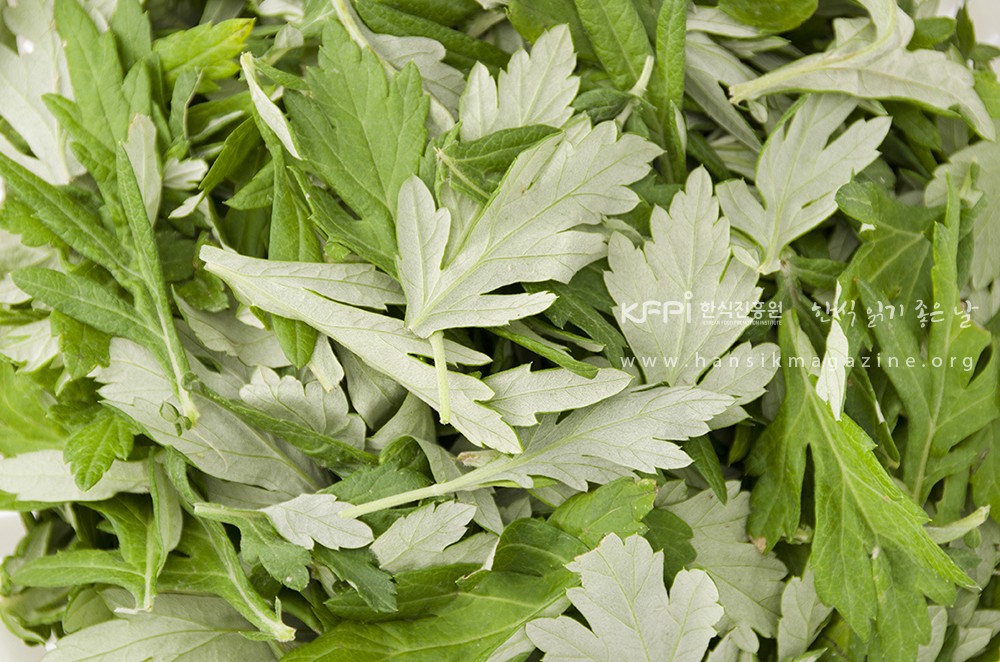한식 읽기 좋은 날
Vol 37. Dodari - Chungcheong
Spring messenger Dodarissukguk, the humanities of perfect harmony
Hansik Archieve
Hansik glossary
Dodari - Flounder
Dodarissukguk - Flunder and mugwort soup
Written by Yun Deokno(Author of <Read Korean life history through food>)
It is said that seasonal food has disappeared, but one of the first foods that properly makes us spring is dodarissukguk(flounder and mugwort soup). The reason is that it is difficult to taste other than spring season, and also the origin of this food is the center of Hallyeosudo, the southern coast where opens the spring of the Korean peninsula. Harmonizing with mugwort, this food gives appetite after the long winter like a messenger telling that spring has come in the sea and the field.
It is hard to find such a fantastic combination like
dodarissukguk to convey the taste of spring

Dodarissukguk is the representative health food of spring
Like the words “spring dodari, autumn gizzard”, spring is the best season for dodari. After spawning, dodari return to the south coast and gain flesh. In addition, fresh spring mugwort comes out after the frozen winter. It gives the feeling of spring as well as the primitive vitality and known as better than ginseng. That's why people who like this dish argue, “If you eat dodarissukguk three times in the spring, you don't have to worry about your health for a year.”
The harmony of dodari and mugwort has created a health food for spring. Then, how it gives such strong spring energy?
Dodari is a flatfish species. There are about 520 species belonging flatfish in the world, and 26 of them live in Korea. Dodari is characterized by a rhombic shape and wider body compared to flatfish or halibut. People say “left flatfish, right dodari” because flatfish’s both eyes are towards left while flounder’s are towards right, but it is not easy to distinguish by appearance unless you are familiar with it. For this reason, in the past, dodari, flatfish, and halibut were all considered similar fish and were called jeobeo(鰈魚).
However, this jeobeo fish proudly insisted that “I am the fish of Joseon”. How dare it said that it is a representative fish of Joseon even with crooked eyes? It’s absurd but there’s a considerable basis for it.
The Korean Peninsula is the country of flatfish

Dodari is one of representing spring ingredients
All the eyes of the flatfish are cornered to one side. Our ancestors thought that the eyes of the flatfish could only see in one direction, so that they could never swim alone and must be paired to move forward. For this reason, they used it as a symbol of harmony, cooperation, trust and faith.
The reason is that dodari and flatfish were the most common fish in Korea. We eat a lot of flatfish without knowing it such as dodarissukguk in the south coast, gajamisikhae(salted and fermented plaice) in Gangwon-do and Hamgyeong-do, gajamimiyeokguk(plaice and seaweed soup) in Gyeongsang-do, and seodeolgui in the west coast. Even these days, the most eaten sliced raw fish by Koreans is flatfish, so the love for flatfish has remained the same. In the past, the Korean peninsula was even called as “the land of flatfish” because a lot of flatfish were produced and loved by the people in here.
We might think that it would be a little embarrassing to hear the nickname “flatfish country” among many other nicknames. However, our ancestors were rather proud of this nickname. Korea is a country with many nicknames. Since ancient times, it has been called Joseon meaning the morning sun rises. Our ancestors liked this name so much that they used it twice as Gojoseon(the old Joseon), and Joseon. Shilla was called Gyerim meaning a rooster in the woods crows to announce the birth of king. Furthermore, it was called Cheongu meaning hill land in the east, and Geunyeok because there were many roses of Sharon.
Along with Joseon, which became the country's name, Jeobyeok, which means the country with many flatfish, was also a nickname that our ancestors were proud of. In the early period of Joseon Dynasty, King Sejo called our land as Jeobyeok in diplomatic documents. Moreover, King Jeongjo in the late Joseon Dynasty also said, “Our country is Jeobyeok where courtesy is important.” But what's so great about the flatfish that made our ancestors take pride in the nickname?
The secret lies in the eyes of flatfish. Whether on the left or on the right, the eyes of plaice, dodari, and flatfish are all cornered to one side. Because of this, people in the old days thought that they could never swim alone because they could only see in one direction. It was called a bimogeo(parallel eyes fish) meaning that they must pair to move forward. It was used as a symbol of harmony, cooperation, trust, and faith, and was also a metaphor of ardent love of husband and wife who share their destiny until death.
In ancient mythology, there is a bird called Biikjo as an animal similar to bimogeo. The male and female each have only one wing, so they must pair to fly and it was also used as a symbol of ardent love. Biikjo lived in the south, and bimogeo lived in the eastern country, Korea. Therefore, the people were proud of the nickname, “land of flatfish” as a symbol of faith and love.
Mugwort gives new vital energy

Mugwort is a spring plant that symbolizes vitality and its taste harmonizes with dodari
Mugwort is also an excellent plant as another ingredient of Dodarissukguk. Dangun’s mother, Ungnyeo ate mugwort and transformed into a human from a bear. Why did the bear eat mugwort to become a human?
The ancient people who created the myth used mugwort as a medium for a bear abandoning its wild nature and seeking humanity. This is because mugwort has the power to drive bad energy out, and it was a symbol of vitality and fertility. There is a saying, “Young ladies living in the remote mountain village mature because of mugwort soup.” It meant the spring mugwort in the mountains maturated young ladies. Some of native Americans in North America had a custom to let women to breathe in mugwort smoke for their coming-of-age ceremony. This ritual was to give vitality.
Dodarissukguk is a combination of this mugwort with dodari. Therefore, it gives appetite in spring and also feeling of love if eat with a partner considering the behind story.

 한국어
한국어
 English
English






